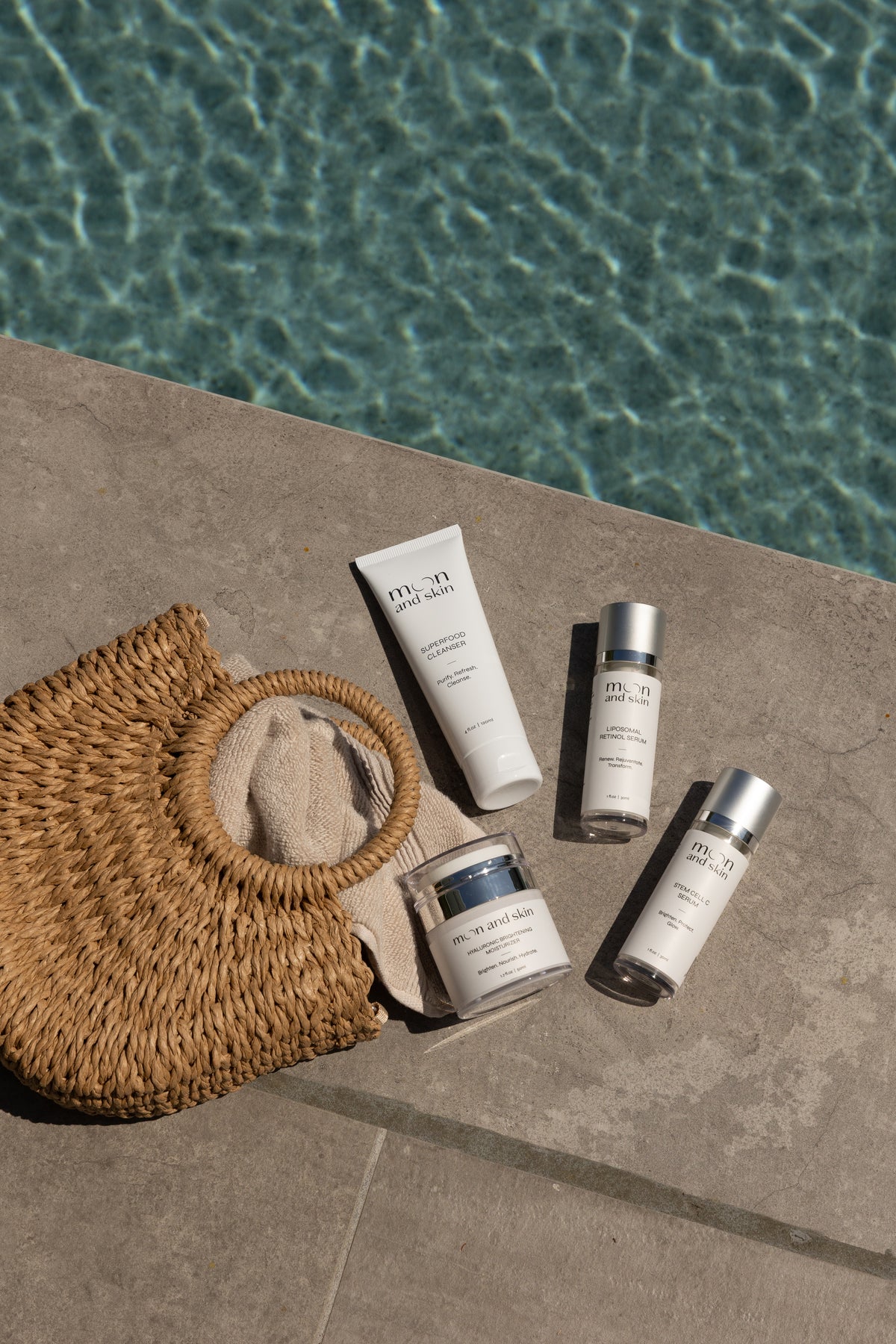Table of Contents
Introduction
Did you know that your skin can age by 10 to 20 years if not properly cared for? The truth is, our skin reflects not only our inner health but also our daily habits and routines. As we journey through life, our skin changes, facing different challenges that require tailored care. Establishing a skincare routine that meets our unique needs and adapts to these changes can feel overwhelming. With countless products and conflicting advice flooding the market, how do we sift through the noise to find the right regimen for our skin?
At Moon and Skin, we believe that navigating the skincare landscape should be an empowering experience. By understanding our skin type, identifying specific concerns, and learning to choose the right products, we can cultivate a skincare routine that enhances our natural beauty and supports our skin through every phase of life. In this post, we will explore how to choose a skincare routine, focusing on essential steps, effective ingredients, and mindful product selection.
In doing so, we aim to demystify the skincare process, allowing you to confidently embrace your skin’s journey. Together, let’s break down the components of an effective skincare routine and discover how our carefully crafted products—like our Stem Cell C Serum—can elevate your skincare experience.
Understanding Your Skin Type
The first and most crucial step in choosing a skincare routine is understanding your skin type. Your skin type can affect how it reacts to different ingredients and products. Here are the five primary skin types:
1. Normal Skin
Normal skin is generally well-balanced—neither too oily nor too dry. It has a smooth texture, minimal imperfections, and is less prone to sensitivity. Those with normal skin can benefit from a broad range of products without worrying too much about irritation.
2. Dry Skin
Dry skin often feels tight, may appear flaky or rough, and can be prone to irritation and redness. For those with dry skin, it’s essential to use rich, hydrating products that help to restore moisture. Ingredients like hyaluronic acid and ceramides are key players in maintaining hydration.
3. Oily Skin
Characterized by excess sebum production, oily skin appears shiny, especially in the T-zone (forehead, nose, and chin). While oiliness can lead to clogged pores and acne, it also has a silver lining—oily skin tends to show fewer signs of aging. Lightweight, oil-free products are ideal for this skin type.
4. Combination Skin
Combination skin features both oily and dry areas, often with an oily T-zone and dry cheeks. Balancing products that address both concerns can be effective. Look for gentle cleansers and moisturizers that hydrate without adding excess oil.
5. Sensitive Skin
Sensitive skin is easily irritated and can react poorly to many products. If your skin is prone to redness, stinging, or burning, it’s essential to choose products with minimal ingredients and calming agents like aloe vera or chamomile.
Identifying Your Skin Type
To determine your skin type, you can perform a simple test:
- Cleanse your face with a gentle cleanser and pat it dry.
- Wait for 30 minutes without applying any products.
- Observe your skin: Is it shiny all over? You likely have oily skin. Is it tight and rough? You may have dry skin. If only your T-zone is oily, it’s combination skin. If it feels comfortable and hydrated, you likely have normal skin. If it reacts negatively, consider it sensitive.
Understanding your skin type can help you choose products that are designed specifically for your needs.
Understanding Your Skin Concerns
Once you’ve identified your skin type, the next step is to pinpoint specific concerns you want to address. Common skin concerns include:
- Acne and blemishes: Caused by excess oil and clogged pores.
- Fine lines and wrinkles: Signs of aging that can be minimized with hydrating and anti-aging ingredients.
- Hyperpigmentation: Dark spots or uneven skin tone often caused by sun exposure.
- Dullness: Skin that lacks radiance may benefit from exfoliation and brightening agents.
- Dehydration: Skin that feels tight or flaky requires additional hydration.
By understanding your concerns, you can choose targeted ingredients that will effectively support your skincare goals.
Targeted Ingredients
- For Acne-Prone Skin: Look for salicylic acid or benzoyl peroxide to help unclog pores and reduce breakouts. Our Superfood Cleanser is a gentle yet effective option that can help cleanse without stripping the skin.
- For Aging Skin: Retinoids (like our Liposomal Retinol Serum) and peptides can stimulate collagen production and reduce the appearance of fine lines.
- For Hyperpigmentation: Vitamin C is a powerful antioxidant that helps brighten the skin and even out skin tone. Our Stem Cell C Serum is formulated with stable vitamin C to help achieve this.
- For Dry Skin: Ingredients like hyaluronic acid and glycerin attract moisture and keep the skin hydrated. Our Hyaluronic Brightening Moisturizer provides deep hydration while also brightening the skin.
- For Sensitive Skin: Choose products with soothing ingredients like aloe, chamomile, and green tea polyphenols. Avoid fragrances and harsh chemicals to minimize irritation.
Building Your Skincare Routine
Now that you understand your skin type and concerns, it's time to construct your skincare routine. A well-rounded regimen typically includes the following steps:
1. Cleanser
A good cleanser removes dirt, oil, and impurities from your skin. Choose a formula appropriate for your skin type. For example, if you have dry skin, opt for a hydrating cleanser, while those with oily skin may prefer a foaming or gel cleanser. Our Superfood Cleanser is designed to nourish while effectively cleansing.
2. Exfoliant
Exfoliation helps to remove dead skin cells, promoting a radiant complexion and improving skin texture. Chemical exfoliants, such as AHAs (alpha hydroxy acids) and BHAs (beta hydroxy acids), offer gentle yet effective options. Depending on your skin type, you can choose a chemical exfoliant that suits your needs.
3. Toner
While not necessary for everyone, toners can help balance the skin’s pH and prepare it for the next steps in your routine. Look for alcohol-free formulas that contain hydrating or soothing ingredients.
4. Treatment
This is where you can add targeted treatments based on your concerns. Whether it’s a serum for anti-aging or a treatment for acne, this step allows you to address your specific skin issues. Our Liposomal Retinol Serum is perfect for those seeking to reduce fine lines and improve skin texture.
5. Moisturizer
Moisturizing is essential for all skin types, even oily skin. It helps lock in hydration and supports the skin barrier. For oily skin, choose a lightweight, oil-free moisturizer, while those with dry skin may opt for a richer cream. Our Hyaluronic Brightening Moisturizer is an excellent choice for deep hydration.
6. Sunscreen
Protecting your skin from UV damage is crucial for maintaining its health and preventing signs of aging. Use a broad-spectrum sunscreen with SPF 30 or higher daily, even on cloudy days.
7. Night Cream (Optional)
At night, your skin undergoes repair and recovery. A night cream can provide added nourishment and help support skin regeneration.
Consistency is Key
One of the biggest mistakes people make in skincare is changing their routine too frequently or expecting instant results. Skincare is a long-term commitment, and consistency is essential for seeing improvements. We recommend sticking to your routine for at least four to six weeks before evaluating its effectiveness.
Building a Full Routine
If you’re unsure where to start, consider our Bundle & Save collection, which combines our four core products into a cohesive skincare routine at a better value. By incorporating our best-selling items, you can enjoy a comprehensive regimen that supports your skin’s health.
Patch Test New Products
Before introducing new products into your routine, always conduct a patch test. Apply a small amount of the product on a discreet area of your skin and wait for 24 hours to see if any irritation occurs. This precaution can help prevent adverse reactions and protect your skin’s integrity.
Consult a Dermatologist
If you’re ever unsure about your skin type or are dealing with persistent skin issues, consulting a dermatologist can provide invaluable insights. A professional can offer personalized recommendations, address specific concerns, and guide you toward effective solutions.
Conclusion
Choosing the right skincare routine is a personal journey that requires understanding your unique skin type and concerns. By following the steps outlined in this post, you can create a regimen that not only enhances your skin's appearance but also empowers you to embrace your skin’s journey.
At Moon and Skin, we celebrate the beauty of every skin type and are here to support you through every phase of life. Remember, skincare is not just about the products you use; it’s about the care and intention you put into your routine. To get started, explore our Best Sellers collection and find the perfect products for your skin.
Embrace your skin’s story and its evolution with us—together, we’ll navigate the world of skincare and celebrate the beauty of your unique journey.
FAQ
Q: How do I know which products are best for my skin type?
A: Start by identifying your skin type (normal, dry, oily, combination, or sensitive) and specific concerns (acne, aging, pigmentation). Look for products formulated for your skin type and concerns, and don’t hesitate to consult a dermatologist for personalized advice.
Q: How often should I exfoliate?
A: Generally, exfoliating 1-3 times a week is sufficient for most skin types. However, if you have sensitive skin, you may want to limit exfoliation to once a week to prevent irritation.
Q: Why is sunscreen important?
A: Sunscreen protects your skin from harmful UV rays that can cause premature aging, sunburn, and increase the risk of skin cancer. It’s essential to apply sunscreen daily, even on cloudy days.
Q: Can I use multiple products for different skin concerns?
A: Yes! You can target multiple concerns by incorporating different products into your routine, but be mindful not to overload your skin. Start with a few targeted products and gradually introduce more as needed.
Q: How long does it take to see results from a skincare routine?
A: Results can vary based on the products used and your skin type. Typically, it takes about four to six weeks to see noticeable improvements, as this timeframe allows your skin to adjust and regenerate.







